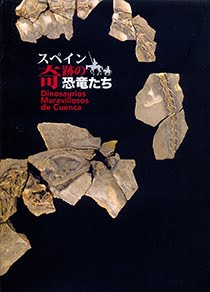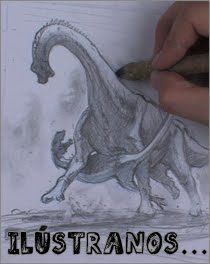Como ya se ha comentado, los días 5 al 7 de septiembre se celebró en Salas de los Infantes (Burgos) las VI Jornadas Internacionales sobre Paleontología de Dinosaurios y su Entorno, donde se han presentado numerosas conferencias y pósteres sobre dinosaurios (restos directos, icnitas y huellas) y flora y fauna asociadas, como cocodrilos, pterosaurios, mamíferos,… y, como no, tortugas.
Uno de los pósteres presentados trataba sobre el estudio de las relaciones filogenéticas de las tres especies de titanosaurios descritas hasta hoy en el Dominio Ibero-Armoricano (España y Francia en el Cretácico Superior). Los resultados más interesantes de dicho análisis es la confirmación de que los titanosaurios del suroeste de Europa no forman un clado monofilético, apareciendo los taxones franceses como litostrotios basales y Lirainosaurus astibiae (el titanosaurio mascota de la Península Ibérica) como miembro del clado derivado Opisthocoelicaudiinae. Estos resultados podrían conllevar unas prospectivas paleobiogeográficas muy interesantes, sugiriendo la posible presencia de dos oleadas migratorias en el Cretácico Superior de Laurasia.
El resumen es el siguiente:
The phylogenetic affinities of the clade Titanosauria have remained as an unfinished puzzle until these last years. In fact, more than 65 taxa are known to date and the larger data sets barely include half the species. Fortunately, several analyses published these last years seem to agree in the occurrence of some clades within Titanosauria, standardizing the general comprehension of the relationships of this clade.The situation of the titanosaurs from southwestern Europe (Ibero-Armorican Island in the Late Cretaceous) is even more stressing, three species are known from Spain and France, and they usually are not included in the phylogenetic analyses that study the intern relationships of the titanosaurs. Lirainosaurus astibiae – from Spain – has been included in about 16 analyses, and in most of them it appears as a derived lithostrotian close to Saltasauridae. Ampelosaurus atacis – from southern France – has been included in about 5 analyses, and in all of them it appears as a basal member of Titanosauria. Atsinganosaurus velauciensis – from southeastern France – has only been included in one analysis, and appears as a basal lithostrotian.The principal aim of this work is to analyze the phylogenetic relationships of the titanosaurs present in the Ibero-Armorican Island. For this we have scored the character states of 25 sauropod taxa (5 basal titanosauriforms and 20 titanosaurs) for 160 characters – list based on the works of Upchurch et al. (2004), Harris (2006), and González Riga et al. (2009), and 3 new proposed characters (Díez Díaz, 2013) –. Giraffatitan brancai has been defined as outgroup, and a traditional search with a TBR swapping algorithm has been realized thanks to the TNT v1.1, with all characters unordered and with the same weight. Six Most Parsimonious Trees of 378 steps were obtained, with a Consistency Index of 0.50 and a Retention Index of 0.54. Most of the clades defined in previous works are well resolved in the strict consensus tree – i.e. Titanosauria, Lognkosauria, Aeolosaurini, Rinconsauria, Saltasauridae, Saltasaurinae and Opisthocolicaudiinae –. Due to the monophyletic assemblages of Andesaurus and Malawisaurus, Lithostrotia appear to be synonymous of Titanosauria.Concerning the Iberoarmorican taxa, the most outstanding result is that they appear as a polyphyletic group. The French titanosaurs appear to be basal lithostrotians, while Lirainosaurus astibiae is a derived member of this clade. These results could have important palaeobiogeographical implications, as Lirainosaurus seems to be more closely related with derived Laurasiatic titanosaurs than with the French and Gondwanic taxa. The inclusion of one of the best known titanosaurs (Rapetosaurus krausei) and more Asiatic taxa in the analysis – e.g. Monogolosaurus haplodon, or the taxa Jiangshanosaurus lixianensis, Qingxiusaurus youjiangensis and Borealosaurus wimani, which are probably closely related with the opisthocoelicaudine titanosaurs – would help to assess the intern relationships of the most derived titanosaurs. In addition, the validity of the clade Lithostrotia will be assessed thanks to the inclusion of more titanosaurian taxa in the phylogenetic analysis. The existence of several migratory events between Asia and Europe, and the role of the Ibero-Armorican Island as a migratory connection between landmasses in the Late Cretaceous are interesting prospects to assess in near future researches.
Más información:





























No hay comentarios:
Publicar un comentario